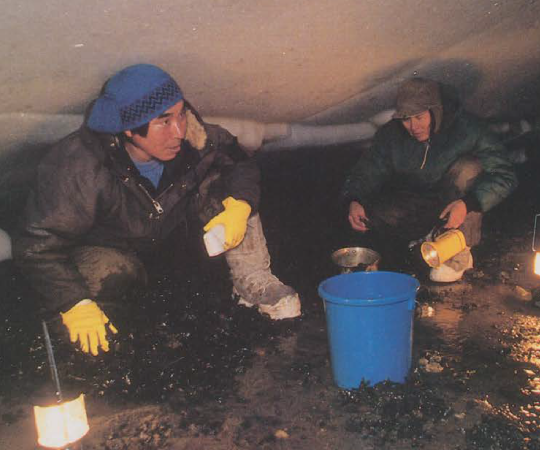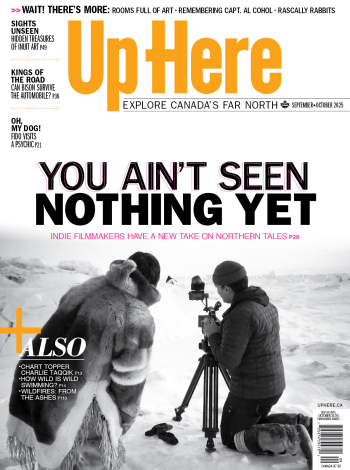It’s a story of resilience. Land rights fought for over generations were finally won, redefining territories. Great riches were chiseled out of the barren rock—literal diamonds in the rough. In Yellowknife in 1984, a plucky magazine, scraped together by guile and a ferocious spirit, became the voice of Canada’s northern landscape. This is the story of the past 35 years. This is the story of the North, as only Up Here could tell it.

THE FIRST DECADE: 1984-1994
A story began in 1984 that’s still being told. Thunderous change was in the air back then. The choices being made demanded a new future for Canada’s territories. Their reverberations still echo, shaping life in the North today.
By chance, Up Here’s first issue came out the same year the Inuvialuit Final Agreement was settled. After a decade of negotiation, the signed agreement with Canada provided surface rights to 91,000 square kilometres, along with new governance and hunting rights for the Inuvialuit. It was only the second comprehensive land claim in Canadian history and the first north of 60. But it would not be the last.
The Yukon signed an Umbrella Final Agreement in 1990 after 20 years of negotiation, providing a blueprint for individual land claim agreements with the territory’s First Nations. In that same year, the comprehensive Dene/Métis land claim in the NWT was rejected, prompting the communities of Rae-Edzo, Whatì, Snare Lake, and Rae Lakes to come together and negotiate on their own. The Tłı̨chǫ land claim agreement would be signed as a result 12 years later. The Sahtu Dene/Métis Final Agreement would finally be ratified in 1993.

In 1988, after several large oil companies began lobbying for the right to drill for oil in Arctic refuge lands, elder Myra “Choo” Kyikavichik of Old Crow gathered Gwich’in communities from across the Yukon, NWT, and Alaska for the first Biennial Gwich’in Gathering. Four years later, the Gwich’in Tribal Council in the Mackenzie Delta signed a comprehensive agreement with the federal government.
But the decade’s biggest land claim—the largest in Canadian history—came in 1993. Ballots were flown in from 27 remote Arctic communities. The stage was set for Canada’s newest territory to redraw the map. A generational struggle to recognize the Inuit homeland culminated in John Amagoalik holding aloft a signed Nunavut Land Claim to a cheering crowd in Iqaluit. “It’s a done deal,” he said. The Inuit received ownership of 375,000 square kilometres, protection of culture, hunting rights, and an $11-billion settlement. The territory of Nunavut was on its way.

Meanwhile, the world was beginning to pay attention to the North. The NWT’s iceberg-shaped pavilion stole the show at Expo ’86. That same year, the northernmost McDonald’s opened its doors in Whitehorse. By the mid-’80s Raven Tours was already escorting Japanese visitors around Yellowknife. The aurora industry was born.
The Northern Arts and Cultural Centre opened in 1984 thanks to an aggressive PR campaign by The Globe and Mail. The national newspaper donated $10,000 to NACC’s fundraising effort and ran full-page ads imploring the rest of Canada to “Help us kill Macbeth in Yellowknife.” In 1985, Nunatta Sunakkutaangit set up shop in a permanent location—a renovated Hudson’s Bay Company warehouse in Iqaluit donated by the government. Inuvik’s Great Northern Arts Festival launched in 1989. Folk on the Rocks celebrated its 10-year anniversary in 1990. North of 60 debuted on CBC in 1992. That same year Susan Aglukark entered the national spotlight with her debut album, Arctic Rose. A fire destroyed Pangnirtung’s Uqqurmiut Centre in 1994, though thankfully the majority of artwork escaped unharmed.
The year of our magazine’s launch also saw Fort McPherson’s Richard Nerysoo become premier of the NWT—the first-ever Indigenous premier in Canada. Four years later, Tulít’a’s Ethel Blondin-Andrew became the first Indigenous woman elected to Parliament. The Liberal MP remained in office for another 17 years. Yukon MP Audrey McLaughlin became the first woman to lead a national Canadian party in 1989 when she took over the NDP leadership from a retiring Ed Broadbent. And Nellie Cournoyea from Aklavik became the first Indigenous woman to lead a government in Canada when she was elected NWT premier in 1991.

And then, there was Giant Mine. Royal Oak Mines Ltd. bought the gold operation in 1990 when the cost of extraction at the aging facility was increasing and the price of gold worldwide was falling. Cost-cutting measures were quickly implemented, alienating workers. When the union’s collective agreement expired in 1992, more than 70 per cent of Giant’s workers voted to strike. Royal Oak locked them out before they got the chance.
In 45 years of labour disputes in Canada, no mining company before Giant had brought in replacement workers during a strike. Royal Oak helicoptered them to the site within hours. The company also hired Pinkerton security agents and strikebreakers from the south. The two sides clashed at Giant’s main gates in early June. Thirty people were arrested. As the strike wore on that summer some workers crossed the picket line. Fights regularly broke out in downtown bars over the issue. School kids wore “No Scabs” buttons to class. Yellowknife was divided and tempers reached a boiling point. A group of miners who dubbed themselves the “Cambodian Cowboys” began a campaign of sabotage involving graffiti and stolen explosives. Workers Al Shearing and Tim Bettger were eventually arrested after a small explosion damaged Giant’s main ventilation shaft. Two weeks later, a railcar passing through a tunnel 230 metres underground tripped another bomb. Nine men were killed.
After a 13-month investigation involving tapped phones and lie-detector tests, striking worker Roger Warren confessed to setting the explosives, revealing details only the bomber would know. Questions nevertheless lingered about whether Warren acted alone or was covering for the actions of his fellow miners. The strike ended the following year in December 1993. The brutal impact of the murders, the truth of who set the explosives, and the bitter chasm between neighbours remained for decades.
“If you were one of the 15,000 people who spent that year watching Yellowknife descend into violent, rabid madness, it’s a time you don’t forget,” wrote Katherine Laidlaw in our pages.

Over in the Barrens, there was another mining story unfolding. After three years of searching, Chuck Fipke and his partner Stewart Blusson discovered diamonds in 1991. The find in Lac de Gras, about 200 kilometres north of Yellowknife, kicked off the largest staking rush in Canadian history since the Klondike Gold Rush days. By 1994 there were exploration camps searching for kimberlite pipes throughout the remote NWT region. It was in that same year that geologists pulled a two-carat brown diamond from the ground at the site of the future Diavik mine.
While the turmoil at Giant was a bloody end to one chapter of the territory's history, the lives of northerners were still clearly linked to the land, and the minerals contained therein. Mining wasn’t leaving the North, but it was changing shape.
Just ask the former residents of Pine Point. Once a thriving community, Pine Point was built to serve workers at the nearby lead and zinc mine. Over its 25-year lifespan, it went from home for 2,000 residents to abandoned ghost town when the mine shut down in 1988. Buildings were sold, demolished or transported elsewhere. A sign hung up by one departing resident on the highway bid a bittersweet farewell:
“Last one to leave, shut off the lights.”










